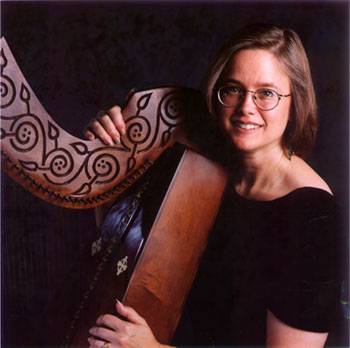Alchemy of a Rose
Track list for this recording
Home ~ Back to Recordings

Review by Julia Duin
Originally published in The Washington Times
January 11 2003
Silver Spring native Cynthia Cathcart hadn’t given much thought to playing a wire harp until she inherited one. Unlike the more typical nylon-strung harps played by harpers with trimmed fingernails, the wire harp comes with strings made of brass, bronze, gold or silver and is played with long fingernails. Of Scottish descent (Clan Ogilvie), she was amazed to learn such harps are known as clarsachs
in the old country and date back to the 10th century.

She’s come out with her first CD of wire–strung harp music, accompanied by a variety of Gaelic instruments: bodhrans, flutes, bagpipes, didjuridus and at the end, a peal from the bells of the National Cathedral. (It took some negotiating with the cathedral bellringers to record the latter.)
Wire–strung harp music is an acquired taste, as the effect is not as mellow as typical harp music. Even for regular harpers, wire–strung music is considered esoteric. This nicely presented CD, which comes with helpful historical explanations and cultural background, contains much that is worthwhile, ranging from the merely pleasant to the haunting.
The best track is the almost nine–minute Brian Boru,
a Scottish war song* dedicated to the victims of September 11. Sounding something like a 21st century Caledonian battle hymn with Revolutionary War overtones (the drum used in this piece was actually used 200 years ago in that war), Brian Boru
starts with a battle horn. The harp then chimes in as a call to war. It evokes a heroic age of warfare before weapons inspectors and security council resolutions — when warriors smeared their faces in blue warpaint and charged. So buy this CD, and if you don’t like it — mail it to Kofi Annan.
—Julia Duin
The Washington Times, Saturday, January 11, 2003
*Brian Boru’s March
is Irish; this was an error on the part of the journalist.